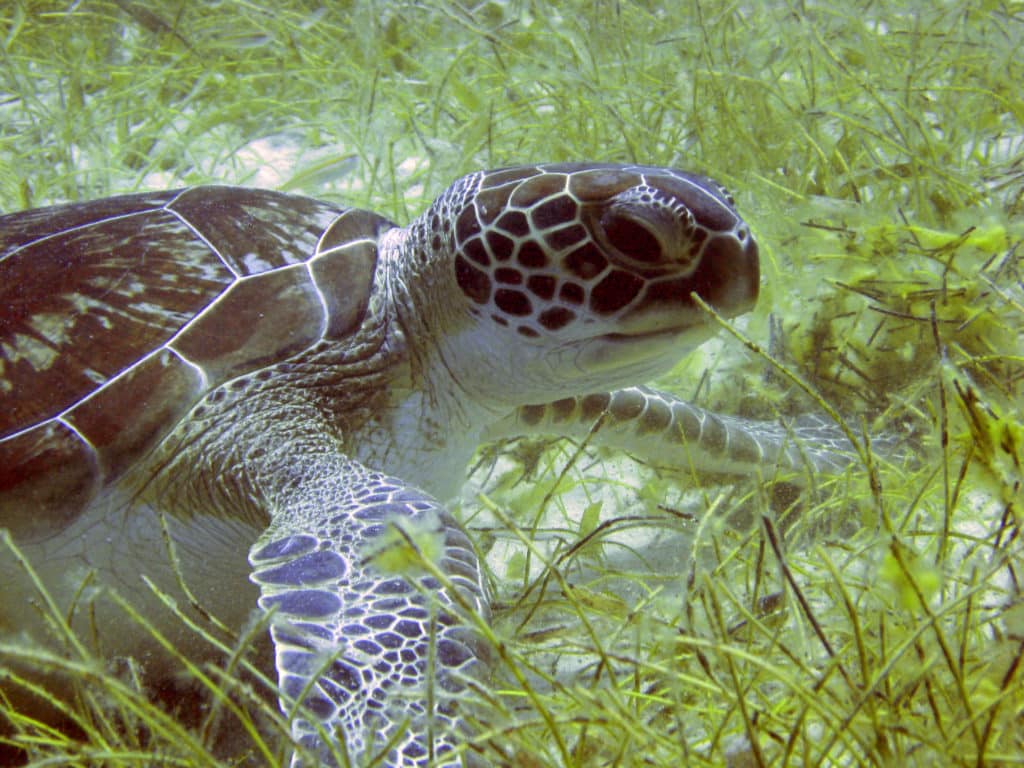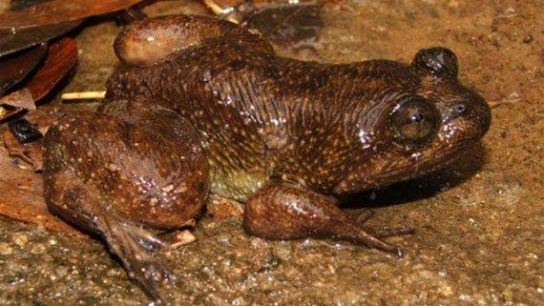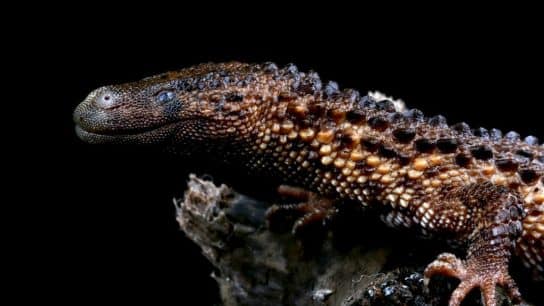The green sea turtle is the second largest of seven sea turtle species and has an incredibly wide geographical distribution, nesting in over 80 countries and inhabiting the temperate, tropical coastal waters of approximately 140 countries. Highly migratory by nature, the remarkable green turtle undergoes complex journeys through climatically varying habitats to reach suitable foraging and nesting grounds. Contrary to common assumptions, the green turtle earned its name through the colour of its cartilage and fat, which derives its notably greenish hue from the strictly herbivorous diet of the species, rather than through the colour of its shell. Despite the implementation of numerous protective measures aimed at safeguarding global green sea turtle populations, threats such as habitat loss, climate change, pollution, commercial fishing and the illegal wildlife trade continue to contribute to the species’ decimation.
—
Family: Cheloniida
Genus: Chelonia
Species: Chelonia mydas
IUCN Status: Endangered
Population: approximately 85,000 to 95,000 nesting females
1. Appearance & Morphology
Although smaller than the leatherback turtle, the green turtle is the largest species of hard-shelled sea turtle, with adults reaching an average carapace length of 83 to 114 centimetres and a weight of 110 to 190 kilograms. Their non-retractable heads are regarded as proportionately small and feature a single pair of prefrontal scales (between the eyes and above the nose), distinguishable from the two pairs found on other species. They exhibit a certain degree of sexual dimorphism upon reaching maturity, as males are typically larger than females and have longer tails, the base of which houses the male reproductive organ. Claws on the fore flippers of male sea turtles also tend to be longer and more curved than those of females, which is thought to assist with grasping onto a female’s shell when mating.
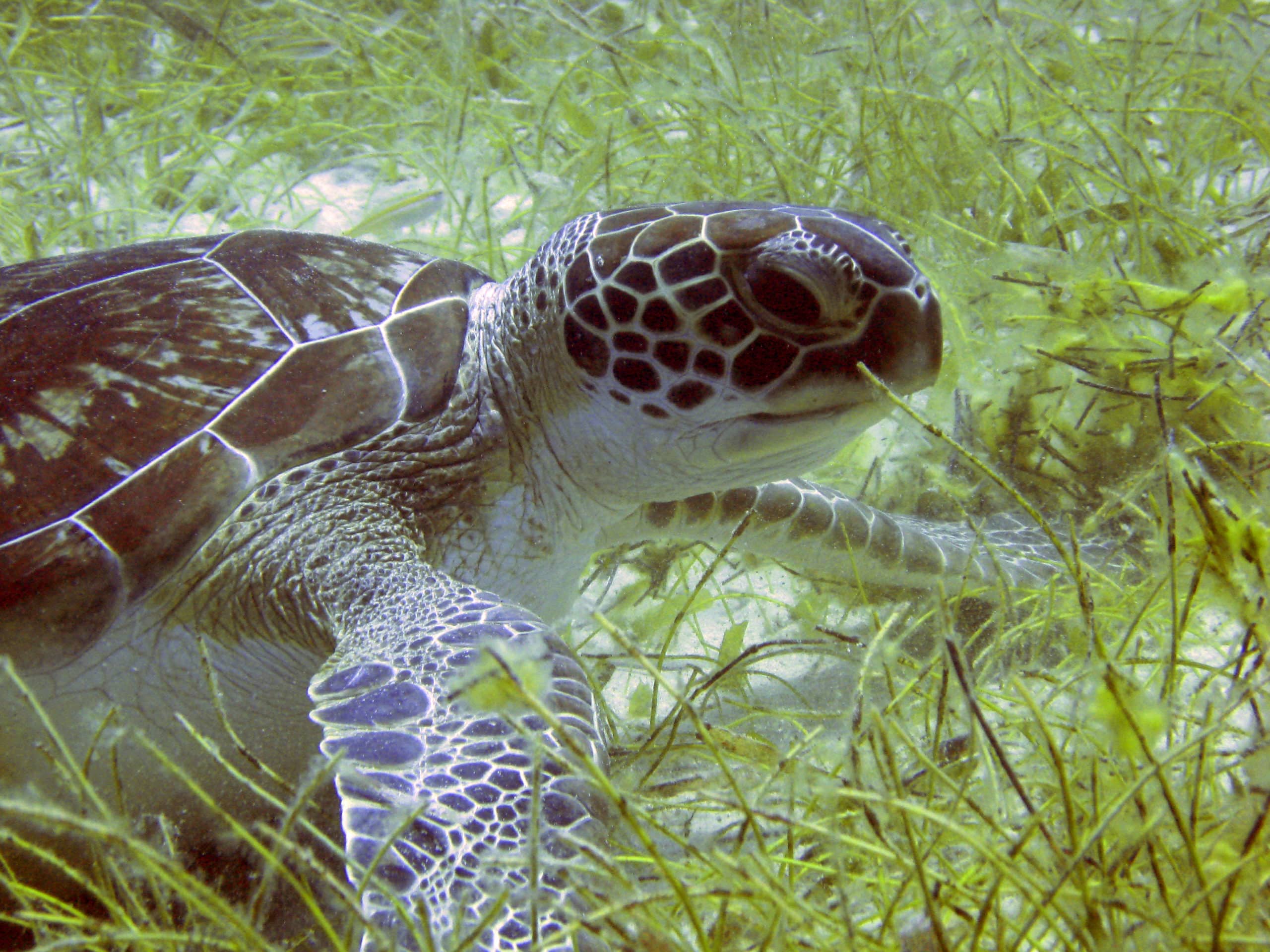
A green turtle has non-retractable limbs and two distinctive prefrontal scales (photo by Flickr user greeny4).
The shell of green sea turtles is made of bone and cartilage, and consists of two parts: the carapace (the top shell), and the plastron (the underbelly). The carapace and the plastron join together at the sides to form a rigid skeletal box. The oval carapace of green sea turtles is absent of ridges, and is composed of five centre scutes (scales) and four lateral scutes on each side, all of which are non-overlapping. Scutes are made of keratin, shedding and regrowing as the turtle matures. In contrast with freshwater turtles, the head and limbs of sea turtles are non-retractable. This adaptation, when combined with the animal’s uniquely streamlined shell, makes them incredibly hydrodynamic in salt water environments. Their large front flippers serve as paddles, propelling them through the water at speeds of 10 to 35 kilometres per hour, whilst their back flippers act as rudders, assisting with steering.
Scientists have long debated the evolutionary history of turtles and their unique shells, as their basic morphological structure has remained relatively unchanged since the Mesozoic Era, and prior to 2008 the oldest known turtle was a species which already possessed a two-part shell (Proganochelys). Whilst palaeontologists typically argue that turtle shells evolved from osteoderms (bony scales beneath the skin, as seen on crocodiles, armadillos and many dinosaurs), which fused with the ribs and backbone in creating a solid shell, developmental biologists instead maintain that the shell evolved from the animal’s ribs, which broadened over time and eventually fused with the spine to form the carapace.
In 2008, the discovery of a 220-million-year-old turtle possessing only the plastron portion of the shell, Odontochelys semitestacea, refuelled discussions on the turtle shell’s evolutionary pathway. The fossil’s upper ribs had begun expanding and the spine had developed bony outgrowths, indicating that the carapace was in the middle of its evolutionary progression. Although the apparent absence of any osteoderms on the fossil seemed to support the arguments of developmental biologists, some continue to claim that the general lack of fossil evidence prevents any definitive answer on the question.

The carapace of a juvenile Atlantic green turtle (left) and an Eastern Pacific green turtle (right) (photo by Javier Rodríguez-Zuluaga for PLoS One).
Shell colours vary greatly amongst green sea turtle populations, of which there are two major ones, Atlantic and Eastern Pacific; although scientists continue to debate whether they constitute two distinct subspecies, two separate species, or simply two sub-populations. Whilst the plastron of Atlantic green turtles is usually yellow or off-white, that of Eastern Pacific populations tends to be dark grey or bluish-green. The carapace of the Atlantic green turtle is more oval-shaped, slightly larger, and flatter than that of its Pacific counterpart, and is typically brown, pale to olive green, or yellow, adorned with iridescent, radiating streaks. Often referred to as the ‘black sea turtle’, the carapace of the Eastern Pacific green turtle is dark grey or black, which is further accentuated by the animal’s naturally darker skin pigmentation. Green se turtle hatchlings are usually black or dark brown with a white underbelly.
Although highly adapted to a marine lifestyle, the kidneys of reptiles such as sea turtles are unable to expel large concentrations of salt through their urine. As sea turtles drink ocean water to hydrate themselves and consume large amounts of algae, they have evolved specialised secretory glands, otherwise known as lachrymal glads, to secrete excess salt. These glands are located by the turtle’s eyes, which is why many people believe that the animals are crying when observed on land.
2. Diet
The diet of green sea turtles changes rather drastically between the time of hatching and when sexual maturity is reached. Beginning with a largely carnivorous diet, hatchlings typically feed on worms, small crustaceans, aquatic insects, and other plant or animal life located in pelagic drift communities (such as Sargassum clusters). Juveniles then adopt increasingly omnivorous feeding habits, consuming sponges, crabs, jellyfish, invertebrates, discarded fish, as well seagrass and algae. Upon reaching adulthood, the green sea turtle then follows a strictly herbivorous diet, mostly consuming seagrass, seaweed and algae, although they may occasionally forage on sponges and invertebrates as well. Remarkably, the green turtle is the only herbivorous species of sea turtle, having developed a finely serrated lower jaw for tearing vegetation and scraping algae off from rocks.
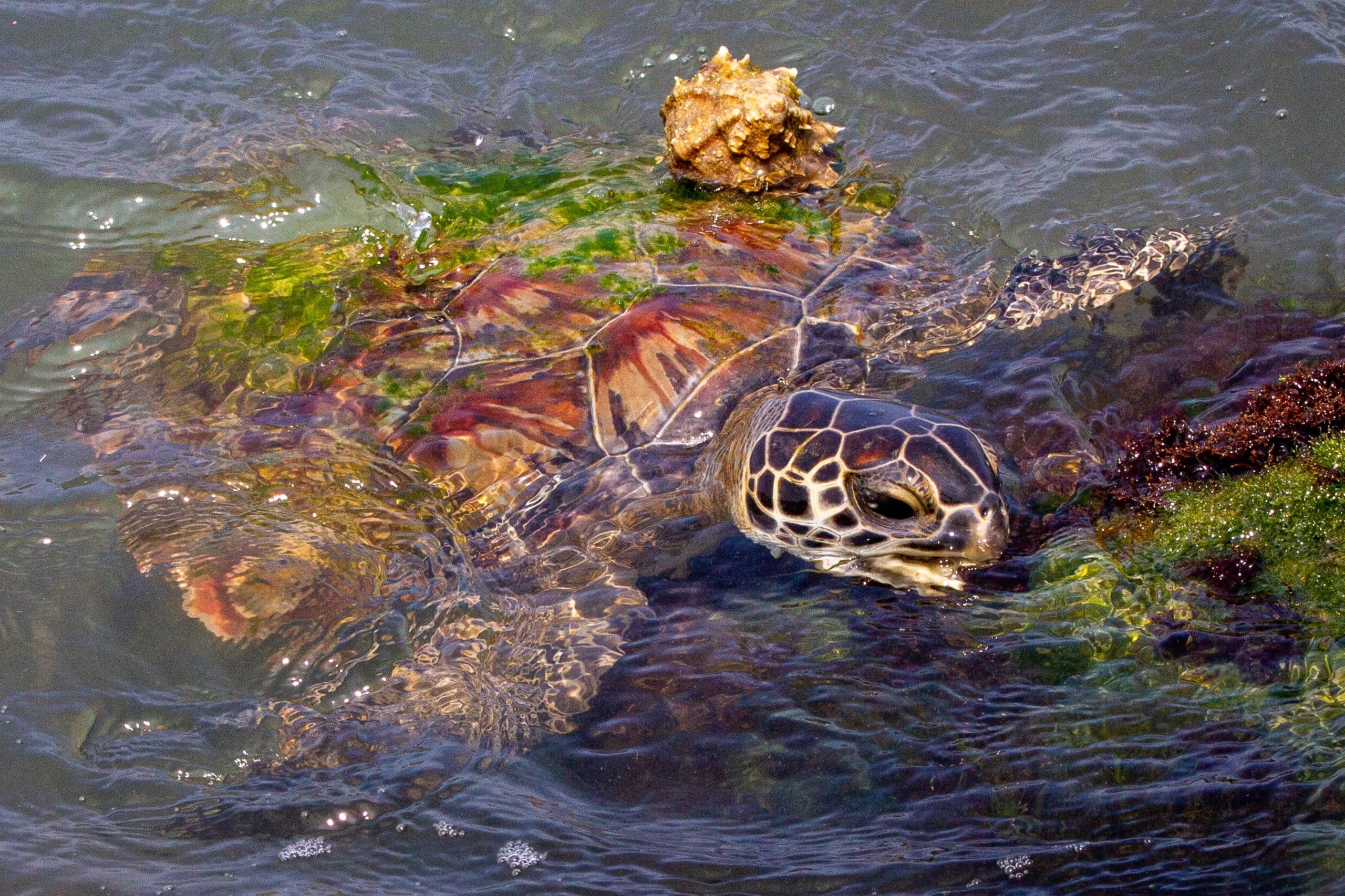
Green sea turtle feeding on some algae (photo by Joshua J Cotten for Unsplash).
3. Habitat and Behaviour
As mentioned, there are two main populations of green sea turtles: Atlantic green turtles are typically found along the coast of Europe and North America, whilst Eastern Pacific green turtles habitually reside in coastal waters between Alaska and Chile. Migratory journeys between foraging grounds and nesting beaches often cover thousands of kilometres and various marine environments, with some crossing entire ocean basins in one migration. To navigate such vast distances, these remarkable creatures use the earth’s magnetic field to determine their geographic location, as each coastline has a unique magnetic signature that sea turtles memorise and utilise as an internal compass. Scientists believe that this propensity for geomagnetic imprinting explains the phenomenon of natal homing in sea turtles, whereby female sea turtles return to the specific beach on which they were born to nest. Nevertheless, as the earth’s magnetic fields gradually change over time, turtles must inevitably shift their nesting sites accordingly.
As a reptile, the green sea turtle cannot breathe underwater and must therefore surface to respire and lay eggs. However, since cold-blooded reptiles are able to control and manipulate their metabolism to a significant degree, green turtles can hold their breath for extended periods of time when resting, approximately four to seven hours. During this time, their heart rate becomes significantly slower, beating once every nine minutes in order to conserve oxygen. To avoid fatal acidosis (high levels of lactic acid in the blood due to an absence of oxygen), sea turtles utilise their mineralised shell to release calcium and magnesium carbonates into their blood, thus neutralising the excess lactic acid.
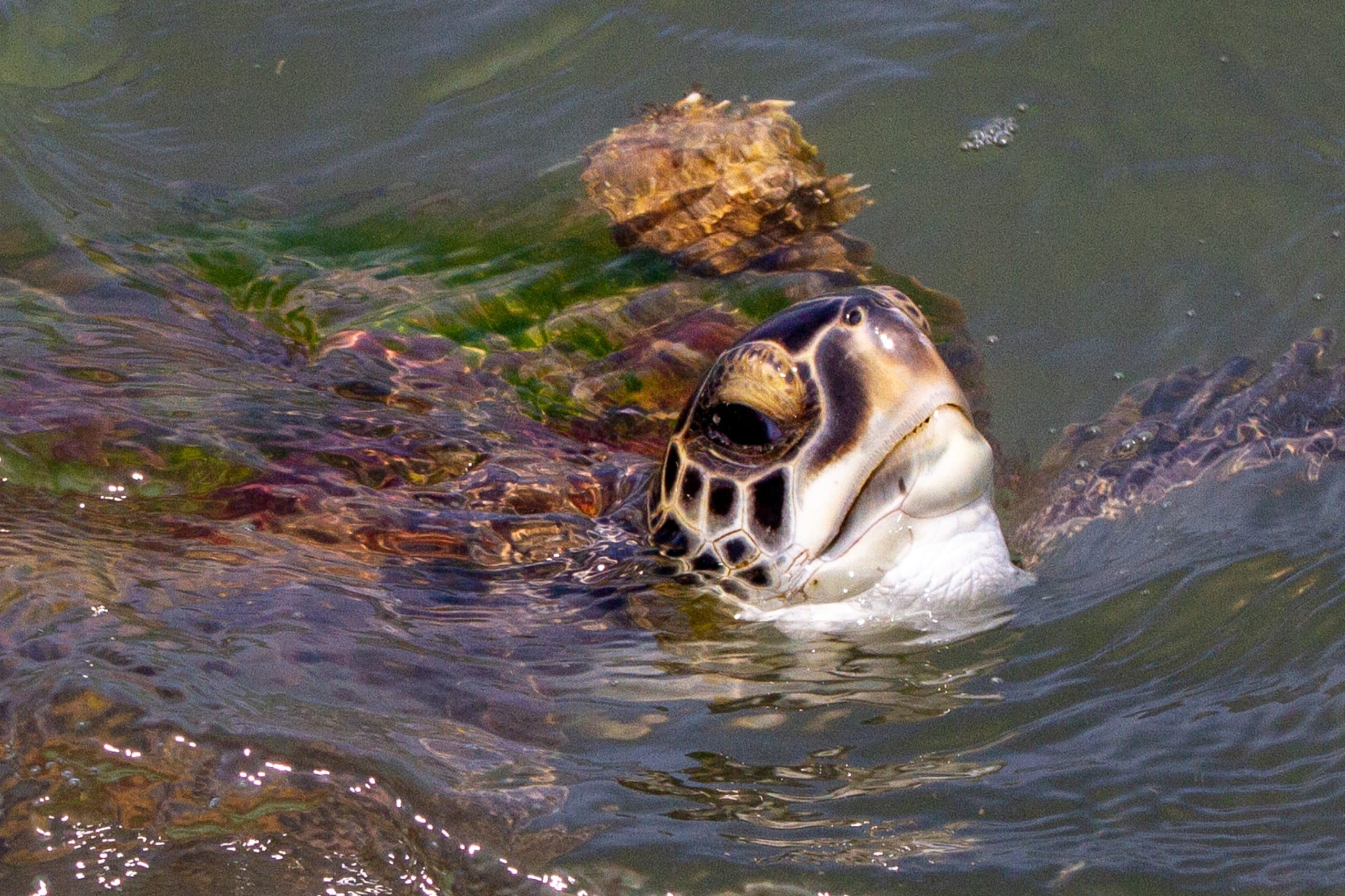
A green turtle surfacing for air, with an observable serrated bottom jaw (photo by Joshua J Cotten for Unsplash).
Green turtles depend greatly on their surrounding environment to regulate their internal body temperature, shifting between cooler and warmer waters according to their needs. Whilst most sea turtles generally swim within shallow, coastal areas to warm themselves, only coming ashore to nest, green turtles have been observed on relatively uninhabited beaches in the Galápagos Islands, Hawaii, and Australia basking in the sunshine along with seals and albatrosses. By warming its carapace to a temperature of 40 degrees Celsius, far higher than the temperature of the water, green turtles have a greater amount of energy to swim and forage with. When faced with drastic temperature drops (below ten degrees Celsius), sea turtles face the risk of cold stunning, a form of hypothermia that causes lethargy, decreased circulation, and a decline in bodily functions. Cold-stunned sea turtles face an increased risk of predation, illness, propellor strikes, and death, as continued exposure to cold conditions result in their bodily functions eventually ceasing.
Upon reaching sexual maturity at approximately 25 to 35 years of age, green turtles mate every two to four years amid shallow coastal waters, after which nesting occurs solitarily and nocturnally. The two most populous green sea turtle nesting areas are the Caribbean coast in Central America, and the Great Barrier Reef in Australia. As mentioned, most adult females will return to the same beach on which they themselves hatched, digging a hole in the sand with their back flippers and depositing a clutch of approximately 100 eggs. Mothers will nest several times over the span of several weeks or months, whilst the eggs remain buried for two months before hatching. As sea turtles are subject to temperature-dependent sex determination, eggs incubated at temperatures below 27.7° Celsius are born as males and those incubated at temperatures above 31° Celsius are born female. Temperature fluctuations during incubation result in a mixture of female and male hatchlings. Once hatched, baby green turtles make the risky journey from nest to sea by following the moon’s light, living within offshore, pelagic habitats for several years. Juveniles then migrate towards more neritic habitats, rich with algae and seagrass, where they reside for the remainder of their adulthood. The life expectancy of green turtles ranges between 50 and 70 years.
4. Services
Green sea turtles play a vital role in maintaining the health and vitality of both marine and terrestrial ecosystems. In following a relatively strict herbivorous diet, primarily grazing on seagrass and algae, these magnificent creatures strengthen the productivity of seagrass beds and their nutrient content, thereby preventing overgrowth, current obstruction, decomposition, and the excessive growth of algae or fungi. By tearing seagrass blades just above the root, meadows kept strong and flourishing, serving as nurseries for numerous species of fish and invertebrates. Once consumed, seagrass is rapidly digested by green turtles and passed as recycled nutrients for the myriad of plant and animal life that live within seagrass ecosystems.
Within terrestrial ecosystems, green turtles directly and indirectly impact vegetation growth, species distribution and the stability of sand dunes through their eggs. Unhatched turtle eggs provide a concentrated source of essential nutrients, such as nitrogen, phosphorus, and potassium, which promote vegetation growth. This shoreline vegetation stabilises sand dunes and barrier islands, protecting inland areas from the effects of ocean waves, currents and tides, and provides sustenance to a range of herbivorous species. Turtle eggs also serve as a source of food to numerous predators, such as crabs, foxes, racoons, feral cats, and vultures – the consequently nutrient-rich faeces of which then promotes further vegetation growth.
Green turtles also maintain both symbiotic and neutralistic relationships with a number of marine creatures. Epibionts are small organisms, such as algae, crustaceans, and barnacles, that attach themselves to the shells of sea turtles to be transported across reefs, seagrass beds and the open ocean. Whilst most maintain neutralistic relationships with the turtle, having little to no effect on its movements, others assist its host turtle by consuming any parasitic epibionts latching onto its shell, or by providing camouflage whilst the turtle rests on the sea floor. However, once a significant number of epibionts have accumulated on the turtle’s shell, they begin to affect the animal’s movements by weighing down its carapace and increasing the drag felt by the turtle. Luckily, green turtles also maintain a symbiotic relationship with certain species of fish, such as wrasses, which feed on the epibiotic organisms found on the turtle’s shell. In recent years, scientists have studied the epibionts found on different species of sea turtles to shed light on their migratory and habitat preferences, as well as their population distribution, in order to establish more strategic, well-informed conservation initiatives.
Green turtles also play an important part in both terrestrial and marine food chains, with eggs, hatchlings and juveniles serving as an important food source for numerous species. As mentioned, unhatched eggs are typically targeted by terrestrial animals such as crabs, racoons, and cats, as they provide predators with a significant amount of protein and nutrients. Hatchlings then face an additional threat of predation from both diurnal and nocturnal seabirds on their journey from nest to sea. Once in the ocean, seabirds continue to possess an aerial view of the hatchlings as they float on the surface. Reef fish, such as groupers and jacks, also prey upon hatchlings. One study found that 97% of green sea turtle hatchlings in Australia are eaten within the first hour of entering the sea. Adult green turtles are less at threat of predation due to their size, although large marine predators such as tiger sharks, great white sharks, and killer whales have been observed preying on green turtles.
Due to the significant effect they have on their surrounding environment, green turtles are a keystone species for many marine ecosystems. The impacts of green sea turtle population declines have been widely observed in the field, affecting the distribution of animal and plant species, as well as the shape and health of marine landscapes. As such, green turtles also play an important role as an indicator species, with their abundance, migratory patterns, reproductive success, distribution, and health all reflecting the quality of their environment. Sadly, the green turtle has further been described as a bioindicator for monitoring plastic pollution in the Northern Pacific Ocean, due to their susceptibility to consuming plastic debris.
5. Threats
Due to their migratory nature, widespread distribution, and inconsistent mating habits, the International Union for Conservation of Nature (IUCN) faced various difficulties in assessing green turtle population trends. Nevertheless, by conducting analyses on 32 globally distributed key index sites, as well as examining both historic and recent accounts of subpopulation declines, the IUCN determined that nesting female subpopulation numbers have decreased by 48% to 67% over the past three generations. Although these key index sites varied in the degree of green turtle subpopulation decline suffered, the perpetuation of numerous anthropogenic threats against a species that already suffers from a naturally high hatchling and juvenile mortality rate has resulted in green sea turtles being listed as ‘Endangered’ since 1982.
Historically, green turtles have been the primary target of both legal and illicit sea turtle hunting, harvested for their eggs, fat, meat, and shells in immense quantities. Excavated human settlements from approximately 7,000 years ago were found to hold sea turtle shells and bones, whilst their meat has been a staple in the diet of tropical and coastal tribes for centuries. Sea turtle eggs are considered to be a delicacy and an aphrodisiac in some parts of the world, such as Central and Latin America, whereas turtle shells and skins are utilised to produce jewellery, glasses, instruments, wall hangings, and ornaments. Sea turtle meat is widely consumed in Southeast Asian countries, such as China, Singapore, Sri Lanka and Indonesia, as well as by coastal communities, such as those in Australia, Fiji, Papua New Guinea, Seychelles, and Nicaragua. In countries such as Australia and Nicaragua, indigenous tribes are legally permitted to hunt green turtles for their own consumption, due to the cultural significance and dependance on the practice. However, the general lack of monitoring within these regions allows poachers to sneak in and hunt for turtles and eggs with relative ease. Concerns of indigenous communities capturing sea turtles for trade on the illicit wildlife market, as opposed to directly consuming the products, have also arisen; although many communities are typically protective of their environment and primary sources of sustenance.
A study conducted in 2014 by the University of Exeter, described as one of the most comprehensive studies on the legal capture of sea turtles, found that more than 42,000 sea turtles are legally hunted each year, 80% of which are green turtles (around 37,000). A mere ten countries were found to be responsible for over 94% of legal sea turtle captures, with Papua New Guinea and Nicaragua accounting for almost 60% of the global reported take. The study estimated that since 1980, approximately two million sea turtles had been legally captured in the 42 countries that continued permit sea turtle hunting at the time of the study. These figures were believed to represent a mere fraction of the total number of sea turtles legally and illicitly slaughtered each year.
Despite the implementation of numerous national and international bans on the capture and trade of sea turtles, such as the Convention on International Trade in Endangered Species of Wild Fauna and Flora (CITES) and the Convention on the Conservation of Migratory Species of Wild Animals (CMS), key consumer countries continue to bypass these protections due to the continued demand for sea turtle products. A 2021 study revealed the existence of numerous farms in China holding up to 5,000 sea turtles in abysmal living conditions, which are illegally sold to aquariums and private buyers across the country. Illegal artisanal turtle fisheries have further been reported across Africa, the Caribbean, Venezuela, and Mexico. In the Cayman Islands, despite an unsuccessful attempt to register the Cayman Turtle Farm under CITES as a legal captive green turtle breeding facility in 2002, the farm continues to breed green turtles for local consumption. Having commenced its operations by taking 477,644 green turtle eggs from wild populations, the farm sells approximately 32,538 kilograms of green turtle meat per year locally. Whilst the farm asserts that the distribution of turtle meat from captive populations aids in reducing instances of wild sea turtle poaching, conservationists maintain that the practice has the opposite effect by creating a public demand for the product, incentivising poachers with the idea that the animals hold high financial value. With extremely poor living conditions, these highly migratory animals suffer from stress, disease, severe injuries, starvation, congenital defects, exhaustion, dehydration, and even cannibalism. Claiming to serve as a conservation and research centre, the release of unhealthy green turtles bred and raised in captivity in fact poses a severe risk to wild populations through the spread of disease and pollution.
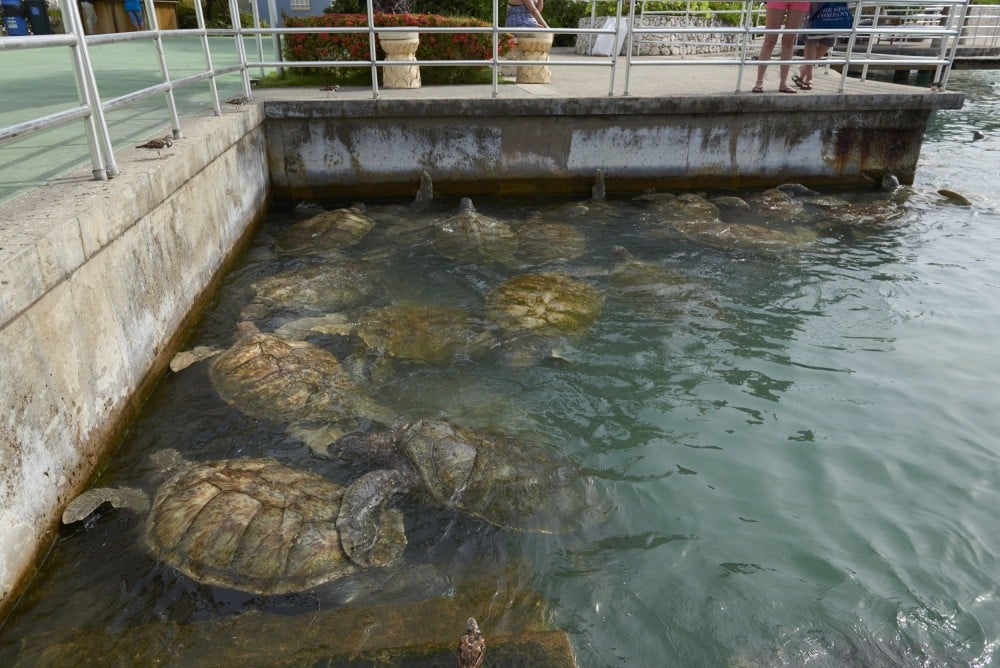
Enclosure at the Cayman Turtle Farm (photo courtesy of the World Animal Protection organisation).
Another major threat to green sea turtle populations is commercial fishing and boating accidents. The widespread and rampant use of irresponsible fishing techniques, such as drift netting, shrimp trawling, dynamite fishing, long-lining, and gill netting, results in hundreds of thousands of sea turtle fatalities each year. Trawlers, for example, catch an estimated 20 pounds of bycatch for every pound of their targeted species. As mentioned, sea turtles must surface for air, unable to hold their breath underwater for very long when distressed; once caught by a fishing net as incidental bycatch, most sea turtles drown before being hauled onto the responsible fishing vessel. The lack of training provided to fishermen on safely untangling bycatch, combined with the absence of regulations surrounding the installation of Turtle Excluder Devices on fishing gear, further increases these mortality rates. For those that are able to avoid drowning, debilitating and even fatal injuries often follow from flipper or neck entanglement, as well as from turtles accidentally swallowing hooks. In 2010, comprehensive studies on sea turtle bycatch estimates for 1990 to 2008 indicated a minimum global bycatch count of 85,000 turtles, although authors of the study suggested a more likely estimate of 85 million turtles due to the notorious misrepresentation of bycatch information provided by fisheries, particularly small-scale ones.
Apart from incidental bycatch, reports of fishermen intentionally harming or slaughtering green turtles have surfaced in Japan, purportedly prompted by the ill-informed belief that sea turtles pose a threat to fishing communities. In July 2022, after 30 green turtles with severe neck injuries were discovered near Kumejima (a Japanese island in the southern Okinawa prefecture) a spokesperson from the Kumejima sea turtle museum, Yoshi Tsukakoshi, shed some light on the views of local fishermen. Due to their propensity to forage near neritic habitats, such as seagrass beds, sea turtles often become tangled in fishing nets laid out by local fisheries, causing damage to the nets. Tsukakoshi further noted that some fishermen erroneously believe that the herbivorous diet of green turtles hinders seagrass beds from growing fully, thus preventing fish from spawning in the region.
Ghost nets and abandoned fishing gears pose an added risk of entanglement to sea turtles, with one report from Brazil detailing the finding of 17 deceased sea turtles entrapped within one ghost net. Since green turtles often reside along coastal environments, swimming and mating near the surface of the water, vessel strikes are also a common occurrence around ports, marinas, waterways, and developed coastlines.
The rampant degradation and destruction of key marine and terrestrial turtle habitats spans far wider than disturbances from commercial fishing and increased boat traffic. Coastal development, such as the construction of property, land reclamation, sand extraction, vehicle traffic, beach armouring and nourishment, has severely limited the availability of suitable nesting grounds for sea turtles. The presence of lights and sounds near nesting beaches can cause behavioural changes in nesting females, deterring them from coming ashore, and can disorient hatchlings, attracting them to light sources away from the water and into urban environments. Heavy vehicle traffic on beaches has the effect of compacting sand, making it extremely difficult for females to dig nests. The creation of coastal structures to protect inland areas from tidal action and the force of waves, such as seawalls, breakwaters, ports, and groynes, causes extensive erosion and prevents the natural process of littoral drifting, thereby leading to the loss of suitable nesting habitats for sea turtles. Attempts to rectify erosion through beach nourishment projects, whereby offshore sand or sediment is pumped onto beaches, severely alter the natural properties and thermal profiles of beaches, affecting the incubation temperatures of nests and the ensuing sex ratios of hatchlings.
Coastal development has also had an enormous impact on the quality of surrounding marine environments, where foraging juvenile and adult sea turtles are typically found. Nutrient run-off from agriculture, contamination through trade effluents, sedimentation, land reclamation and beach restoration projects severely pollute ocean habitats and destroy nearshore feeding grounds, such as seagrass beds, whilst marine algae resources are regularly over-harvested.
Plastic pollution is another major contributor to habitat degradation in both terrestrial and marine environments. On nesting beaches, high volumes of plastic and debris can prevent females from nesting (known as a false crawl) and obstruct hatchlings from entering the ocean. In a 2016 study, researchers found that removal of large anthropogenic debris from beaches resulted in a 200% increase in the number of nests dug by sea turtles. Within marine environments, approximately eight million tonnes of plastic enters the ocean every year, joining the five trillion tonnes that currently float within the ocean’s water columns. Hatchlings often mistake microplastics for their preferred diet of small crustaceans and aquatic insects, feeding instead on indigestible materials such as small pieces of hard plastic, nurdles, and synthetic textile materials. In July 2022, a green turtle hatchling rescued from a beach in Sydney excreted nothing but plastic for six days, indicating that the turtle had only been exposed to plastic as an initial food source. As adult green turtles follow a herbivorous diet, they tend to mistake narrow lengths of green and black plastic for algae and seagrass, consuming strips of plastic bags and fragments from ropes. In a 2019 study, scientists from the University of Exeter and the Society for the Protection of Turtles examined the stomach and gastrointestinal contents of adult green turtles found washed up on the beaches of Cyprus. All were found to contain plastic, with one found to have consumed 183 pieces.

Stomach contents of a juvenile green turtle founded stranded in Cananéia, Brazil (photo by Daiana Bezerra).
Another source of marine and terrestrial pollution are petroleum products, which habitually enter the sea through intentional vessel discharge, the transport of oil products, oil spills, offshore oil exploration, vessel refuelling, and land run-off (oil residue from roadways and the improper disposal of oil). Oil from offshore spills tends to concentrate along convergence zones, where oceanic currents meet, which are important foraging areas for young sea turtles. The stomach contents of deceased hatchlings and juveniles have been found to contain oil and tar balls (degraded crude oil), whilst oil floating on the surface of the ocean is often inhaled by turtles, coating their throats, lungs, and digestive tracts. Pregnant sea turtles that ingest oil can pass toxic compounds (polycyclic aromatic hydrocarbons, or PAHs) into their eggs, affecting the health of hatchlings. Petroleum products also contaminate many primary food sources for sea turtles, such as fish, crabs, seagrass, and algae, as well as killing the pelagic habitats of young sea turtles, such as sargassum clusters.
Marine pollutants, such as microplastics, toxic metals, PCBs (polychlorinated biphenyls), industrial and agricultural run-off (fertilisers, pesticides, chemicals, nutrients, untreated waste), petroleum products, and 6PPD-quinone (car tyre dust), greatly affect the health of sea turtles at all stages of life. If not immediately harmed through direct contact, continuous exposure to such pollutants causes a gradual build up of toxins in the bodily tissue of marine turtles, resulting in immunosuppression, disease and death. Although the commercial production of PCBs has been banned in most countries around the world, these chemicals can still be found within the environment and in products manufactured prior to bans. Ingestion of PCBs can lead to illness, disease, and impaired reproductive functions, with scientists having discovered traces of PCBs in sea turtle eggs. In recent years, the increasing prevalence of Fibropapillomatosis (otherwise known as FP) in sea turtles has been linked to the rapidly declining quality of marine habitats, causing a significant number of fatalities in Florida, Hawaii, the Caribbean and Australia. FP is a disease that causes the growth of tumours on the eyes, mouth, soft-skin areas, and internal organs of marine turtles, affecting their ability to swim, feed, see and breathe, and thus making them more vulnerable to vessel strikes and predation. Whilst FP is most prevalent in green turtles, affecting 50% of the Florida Indian River green turtle population, the disease has also been observed in loggerheads, flatbacks, Olive Ridleys, and Kemp Ridleys.

Green sea turtle found stranded with several Fibropapiloma tumors (photo by Bárbara Oliveira De Loreto).
Lastly, the ever-present threat of climate change poses a significant risk of extinction to sea turtles, as rising sea levels, increasingly warm ocean temperatures, and unpredictable climate events cause significant amounts of damage to turtle populations. Global sea levels have risen by 21 to 24 centimetres since 1990, with numerous locations along the US coastline suffering high-tide flooding 300% to 900% more often than 50 years prior. Accelerating rates of sea level rise, as well as increasingly frequent and intense climate events, have made key nesting beaches highly vulnerable to flooding and erosion. In Australia, inundated nest sites have resulted in hundreds of drowned eggs, and beach erosion has led to the formation of mini cliffs from which nesting turtles fall. Warming ocean temperatures have drastically changed the distribution, abundance and health of primary sea turtle food sources, leading to shifts in migratory routes, foraging locations and nesting seasons. Hotter surface temperatures have altered the morphology and thermal profiles of beaches, disrupting natural sex ratios of hatchlings and causing numerous fatalities in extreme conditions. In August 2022, scientists revealed that nearly every sea turtle born in Florida over the past four years has been female due to unnaturally warm temperatures. On Raine Island (off the coast of the Great Barrier Reef), one of the largest green sea turtle rookeries on earth with more than 200,000 nesting turtles and records of 18,000 females nesting at one time, female hatchlings outnumber males by 116 to 1. These unbalanced sex ratios concern scientists as they predict sea turtle populations will ultimately become stunted in affected regions. Under such rapid and dynamic environmental changes, sea turtles are understandably unable to adapt naturally.
You might also like: 7 Interesting Facts About Sea Turtles
6. Conservation
Once international scientists and conservationists began observing the negative impacts of anthropogenic activity on sea turtle populations, many began publicly campaigning and implementing strategies to mitigate such threats. After decades of scientific research, education programs, government advocacy, eco-tourism initiatives and technological breakthroughs, international awareness surrounding the plight of sea turtles and public involvement in conservation efforts has increased exponentially. Although there remains a tremendous amount of work to be done in safeguarding the continued existence of sea turtles, the incredible efforts of dedicated individuals and organisations has already made a significant difference in some regions of the world.
By the 1970s, government officials and conservationists were already aware of the grave threat of extinction that commercial fisheries posed to sea turtle populations, particularly shrimp trawling. In collaboration with numerous environmental groups, the National Oceanic and Atmospheric Administration (NOAA) commenced a gear development project aimed at creating a device to reduce instances of incidental sea turtle bycatch. After years of research, trials, and modifications, the Turtle Excluder Device (TED) device was created, boasting a turtle capture reduction rate of 97% and a minimal amount of shrimp loss. Although most fishermen across the US refused to voluntarily utilise TEDs when the product was initially distributed, federal regulations mandating the use of TEDs in the US shrimp fishing industry, as well as the development of lighter, smaller and more affordable TED designs, have resulted in many shrimp fisheries in the Gulf of Mexico and the South Atlantic using TEDs on their shrimp trawlers. Since the 1990s, the NOAA has also worked with several partners in assisting countries across the globe to develop their own TED regulations, resulting in approximately 40 countries having similar reductions in sea turtle bycatch rates.
Studies conducted in 2016 also proposed the use of illuminating nets with light-emitting diodes (LEDs) to reduce instances of sea turtle bycatch in smaller, bottom-set gillnet fisheries. Experiments demonstrated a 63.9% reduction in sea turtle bycatch with the illuminated nets, which were further found to be cost effective with financial support from national ministries and NGOs. Organisations such as the World Wide Fund for Nature (WWF) have been working to replace j-shaped fish hooks with the more turtle-friendly circle hook within international fisheries, as well as running a global competition for innovative solutions to bycatch in commercial fisheries, and using satellite monitoring to implement spatial and temporal closures when sea turtles are at close proximity to fishermen. WWF-Pakistan has also trained around 100 fishermen and crew members on the safe release of entangled sea turtles, as well as on a modified method of operating gillnets, which has resulted in a bycatch rate reduction of 85% in the region. In collaboration with TurtleWatch, the NOAA further developed a software known as EcoCast, which fishermen can use to determine where their target species are likely to be in relation to protected species, optimising their yield with the lowest possible bycatch ratio.
Attempts to mitigate plastic pollution have also been widely implemented across the world, with numerous international bans on the production of plastic and mass beach cleanup efforts driven by environmental conservation. In July 2021, the European Union banned single-use plastics and polystyrene products, such as plastic bottles, straws, takeaway containers, and coffee cups, following similar bans in New York, California, Thailand, China, India, and Seychelles, as well as proposed plastic-reduction strategies in Canada, Indonesia, Chile, Japan, and the US. SeeTurtles has implemented a number of community-based beach and coastal cleanup programs in Malaysia, Uruguay, Mexico, Kenya, Curacao, and Colombia, having established recycling centres and responsible waste collection and management systems within coastal communities. In 2018, a two-year beach cleanup operation led by a local lawyer in Mumbai transformed the rubbish-laden coastline of Versova into an incredibly pristine beach, described by the United Nations as the “world’s largest beach cleanup project”, on which Oliver Ridley turtles were later observed nesting for the first time in decades.

A Sea Turtle Conservancy team surveying nests to determine hatchling productivity (photo courtesy of the Sea Turtle Conservancy).
The protection of key sea turtle habitats through the establishment of marine protected areas, coastal national parks, eco-tourism initiatives, research stations, and community education campaigns has also been instrumental in the prevention of sea turtle poaching, bycatch, and habitat destruction. Working in collaboration with TRAFFIC, the largest international wildlife trade monitoring organisation, WWF has trained local patrollers and rangers on the protection of sea turtles on nesting beaches, further encouraging governments to strengthen legislative measures against poaching and provide the necessary funds for fruitful conservation strategies. By educating local communities on the ecological importance of sea turtles and providing them with an opportunity to effectively safeguard their resident turtle populations, locals who once based their livelihood on the extractive use of sea turtles are given the opportunity to earn a living through eco-tourism. Local hunting bans in numerous countries around the world have also had some success in reducing instances of poaching. A hunting ban implemented by the government of Seychelles in 1968, prompted by the rapid and alarming decline of local populations due to intensive harvesting, has resulted in a fivefold expansion in the number of nesting turtles on the Aldabra Atoll since the ban was announced. This achievement has exemplified the importance of long-term population monitoring, which has yielded similar sea turtle conservation successes in Australia, Costa Rica, Mexico, Ascension Island, and Hawaii.
Research conducted by conservationists on the migratory, foraging and nesting patterns of sea turtles, through the use of satellite monitoring technology, has also informed international governments on the need for marine protected areas (MPAs), as well as protected migration corridors, to reduce instances of bycatch and vessel strikes. A study conducted in May 2022 on the regional network of MPAs off the West African coast (RAMPAO), home to one of the largest green sea turtle nesting populations, indicated that the tracked turtles spent the majority of their time foraging and nesting within the 24 MPAs in the region. However, only 21% of key migratory corridors, which the green turtles utilise to move from foraging to nesting grounds, fell within MPA boundaries. These corridors were found to be close to shore and habitually utilised by local fisheries, indicating the need to implement further protections in these regions to ensure the connectivity of MPAs and the protection of turtles undertaking migratory journeys.

The Sea Turtle Conservancy releasing a satellite tagged turtle (photo courtesy of the Sea Turtle
Conservancy).
NGO Spotlight: Sea Turtle Conservancy
One group at the forefront of marine turtle conservation is the Sea Turtle Conservancy (STC), one of the oldest and most accomplished sea turtle organisations in the world. STC commenced its operations in 1959 as a result of Dr. Archie Carr’s alarming findings in Tortuguero, Costa Rica – one of the largest green sea turtle rookeries in the world. Dr. Carr discovered an economy based entirely on the extractive use of green turtles, with the rampant harvesting of eggs and turtle meat posing a severe threat to the species’ existence. Now, more than 60 years later, STC has helped establish a global movement dedicated to the protection of sea turtles around the world. Using scientific research, habitat protection, community outreach, education programs, networking, and policy initiatives, STC continues to mitigate the negative impacts of anthropogenic activity on all seven species of marine turtles, as well as the myriad of habitats and ecosystems they interact with.
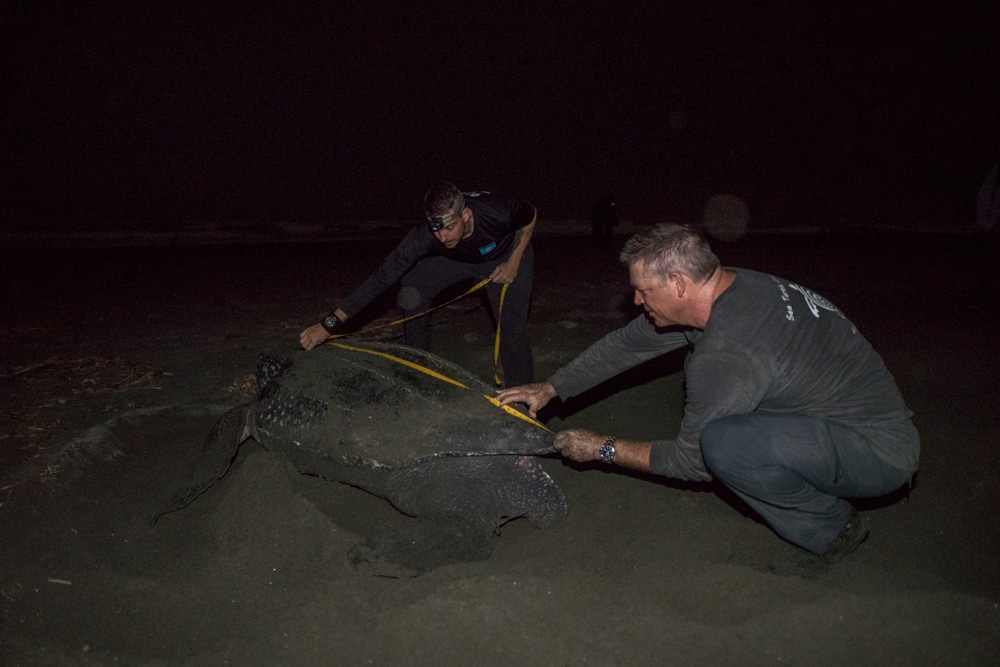
STC team measuring and assessing the health of a nesting leatherback sea turtle (photo courtesy of the Sea Turtle Conservancy).
In Tortuguero, STC’s research and recovery program is the most successful project of its kind in the world, with biologists measuring, tagging, and assessing the health of each female observed on the beach during nesting season, as well as surveying nests to determine hatchling productivity. Similar initiatives have been launched in Panama, Bermuda, and Florida, equipping sea turtles with satellites for monitoring migration routes, foraging preferences and nesting habits. The launch of a systematic monitoring program in 2019 further enabled STC to understand the population density, growth, diet, movement and health of important sea turtle populations. In doing so, STC have been better able to support the advocacy and policy shaping projects they coordinate, working with governments to regulate commercial fisheries, fight the illegal wildlife trade, mitigate the impacts of oil spills and coastal development, protect critical habitats, and promote the establishment of eco-tourism operations as an alternative livelihood to poaching. Known as a trusted source of information for policymakers and the general public, STC provides the necessary research and data to implement effective, informed conservation strategies.

An example of STC’s retrofit turtle-friendly lighting program (photo courtesy of the Sea Turtle Conservancy).
STC further collaborates with coastal communities, businesses, governments and conservationists in garnering awareness on the plight of sea turtles, as well as in implementing local initiatives to mitigate threats such as light, sound and plastic pollution. The Tour du Turtles program, which follows the migration of several different species from foraging to nesting grounds, has allowed over 500,000 students to learn about sea turtles and the ecological importance they hold. Sea turtle walk programs operated by local guides promote the importance of eco-tourism, educating visitors on responsible tourism practices whilst controlling the number of people on nesting beaches. STC has also become known as a key resource for environmentally-friendly coastal lighting practices, informing local communities about the effects of artificial lights on nesting beaches, and implementing retrofit programs to equip beachfront businesses and properties with turtle-friendly lights.
How to Help the Green Sea Turtle
- Avoid buying seafood, or opt for responsibly caught seafood. Thousands of sea turtles are caught as bycatch every year due to the reckless use of harmful fishing methods. Do your research before heading out to the supermarket and check which seafood brands use ethical fishing practices to source their products. If you can, reduce your weekly seafood consumption and opt for veggie alternatives, as greenwashing is a common practice amongst seafood suppliers.
- Say no to plastics. All marine animals suffer greatly from the enormous amount of plastic pollution found across the earth’s oceans. Avoid using plastic carrier bags, bottles, utensils, straws, individually-wrapped food products (especially condiments), and dispose of any plastics you do use responsibly and ethically, recycling whenever possible.
- Reduce your carbon footprint. Climate change is one of the biggest threats faced by global sea turtle populations, so walk or bike when you can, opt for public transportation when its available, go veggie a few times a week, reduce your energy consumption by unplugging your electronics, try out some thrift shops and second-hand clothing stores next time you go shopping, eat local produce, and dry-line your clothes whenever the sun is out.
- Shop ethically. Avoid purchasing souvenirs made from turtle shells or skin when travelling abroad. Don’t be afraid to ask the shopkeeper what certain products are made of. If in doubt, don’t purchase it.
- Support a sea turtle organisation. There are numerous incredible organisations, such as the Sea Turtle Conservancy and See Turtles, that implement a number of conservation programs and strategies around the world to safeguard sea turtle populations. You can help by donating funds, starting a fundraiser, volunteering, organising beach or coastal clean-ups, and spreading awareness.
If you enjoyed this article, you might also like: Galapagos Penguin: Endangered Species Spotlight










